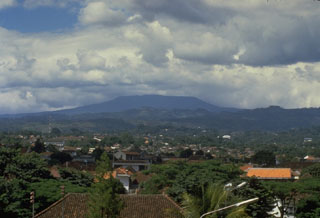Report on Tangkuban Parahu (Indonesia) — 31 July-6 August 2019
Smithsonian Institution / US Geological Survey
Weekly Volcanic Activity Report, 31 July-6 August 2019
Managing Editor: Sally Sennert.
Please cite this report as:
Global Volcanism Program, 2019. Report on Tangkuban Parahu (Indonesia) (Sennert, S, ed.). Weekly Volcanic Activity Report, 31 July-6 August 2019. Smithsonian Institution and US Geological Survey.
Tangkuban Parahu
Indonesia
6.77°S, 107.6°E; summit elev. 2084 m
All times are local (unless otherwise noted)
PVMBG reported that an eruption at Tangkubanparahu's Ratu Crater, recorded at 2046 on 1 August, generated a dense black ash-and-sediment-laden plume that rose about 180 m from the bottom of the crater, and light-colored ash plumes mixed with water vapor that rose 200 m and drifted N and NE. The event lasted 11 minutes and 23 seconds based on seismic data. Ash and sediment fell in areas around the crater. Four eruptive events were recorded during the morning of 2 August, though ash emissions were not visually observed. The Alert Level was raised to 2 (on a scale of 1-4). A period of continuous ash emissions was recorded during 2-4 August.
Geological Summary. Gunung Tangkuban Parahu is a broad stratovolcano overlooking Indonesia's former capital city of Bandung. The volcano was constructed within the 6 x 8 km Pleistocene Sunda caldera, which formed about 190,000 years ago. The volcano's low profile is the subject of legends referring to the mountain of the "upturned boat." The Sunda caldera rim forms a prominent ridge on the western side; elsewhere the rim is largely buried by deposits of the current volcano. The dominantly small phreatic eruptions recorded since the 19th century have originated from several nested craters within an elliptical 1 x 1.5 km summit depression.
Source: Pusat Vulkanologi dan Mitigasi Bencana Geologi (PVMBG, also known as CVGHM)

